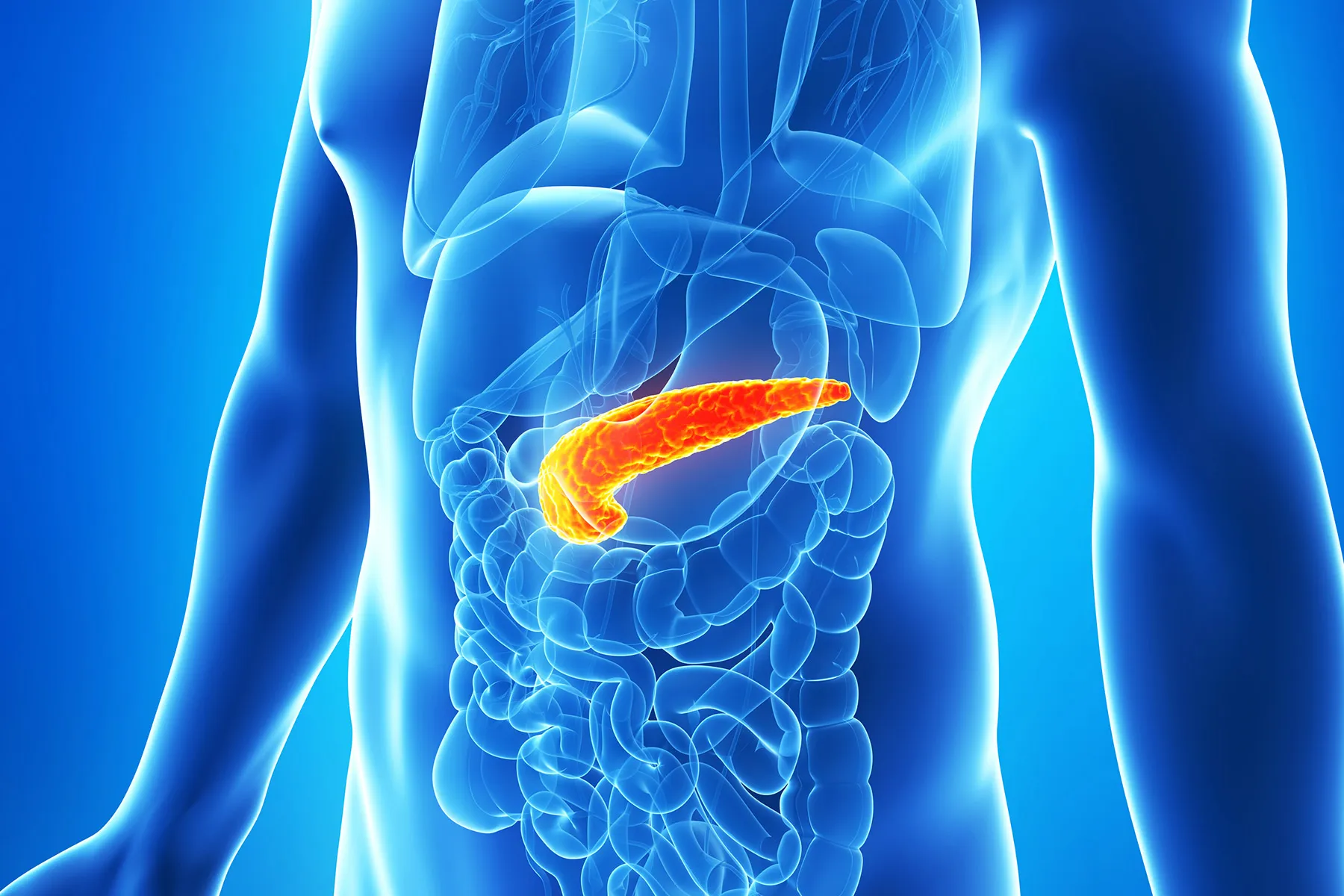Your pancreas is a gland that makes enzymes to digest your food and hormones to regulate your blood sugar levels. Your pancreas is shaped like a comma and located deep in your belly, between your spine and your stomach. The head of your comma-shaped pancreas is on the right side of your belly, tucked into where your small intestine starts. The body and tail of your pancreas extend to the left, across your belly. Because it’s so deep inside your belly, you may not have any symptoms or signs that anything is wrong until your condition is advanced.
 Because your pancreas is deep in your belly, you may not have symptoms of pancreatic cancer until after it has grown large or spread to other organs. (Photo Credit: Science Photo Library/Getty Images)
Because your pancreas is deep in your belly, you may not have symptoms of pancreatic cancer until after it has grown large or spread to other organs. (Photo Credit: Science Photo Library/Getty Images)
The pancreas has a couple of types of cells: exocrine and endocrine cells. Exocrine cells make enzymes that help you digest food. About 90% of pancreatic cancer start as adenocarcinoma tumors in these exocrine cells. Usually, it starts in the cells that surround the pancreatic duct that feeds digestive juices into your small intestine.
Endocrine cells make hormones like insulin and glucagon that help regulate your blood sugar. Less than 10% of pancreatic cancers start in these endocrine cells. These cancers are called pancreatic neuroendocrine tumors (NETs), and they tend to grow slower than pancreatic adenocarcinoma tumors.
Read on to learn more about the symptoms of pancreatic cancer, whether it starts in the exocrine cells or endocrine cells.
Early Signs of Pancreatic Cancer
One of the challenges with pancreatic cancer is that the symptoms are often vague and unexplained. This means that the symptoms can be caused by a lot of different conditions that are much more common than pancreatic cancer. You may not think to go to the doctor if you get diarrhea and indigestion a couple of days a week for a few months. This is because you’re symptoms are much more likely to be from a viral infection or a condition like irritable bowel syndrome or colitis than pancreatic cancer.
You’re more likely to have early symptoms from a pancreatic neuroendocrine tumor than from an adenocarcinoma. This is because a neuroendocrine tumor can make hormones that regulate your blood sugar levels. In this case, you may have digestive symptoms like diarrhea, indigestion, unexplained weight loss, and blood sugar changes.
If you have an adenocarcinoma that starts in the head of your pancreas, you may develop jaundice (yellowing of the whites of your eyes and skin) early on, before your cancer has grown large or spread outside your pancreas. This isn’t specifically a sign of pancreatic cancer; there are many less serious conditions that can cause jaundice, such as gallstones. But if you develop jaundice, it’s important to go see your doctor to get to the bottom of it.
Pancreatic Cancer Symptoms
Early on, pancreatic adenocarcinoma tends to be silent and painless as it grows. By the time you notice symptoms, pancreatic cancer from adenocarcinoma has generally spread outside of your pancreas. But you may have symptoms earlier from cancers that start in the head of your pancreas. Cancers that start in the body and tail of your pancreas may not cause symptoms until later on.
Another challenge with pancreatic cancer is that the symptoms can be caused by a number of conditions that are much more common than pancreatic cancer. Having any or all of these symptoms doesn’t mean that you have pancreatic cancer. But if you do have several of these symptoms, it’s time to see your doctor.
If you do notice symptoms, they may include:
Fatigue or physical weakness
You may feel very tired and physically weak even when you haven’t done any physical activity. You may also have trouble sleeping and feel depressed. You may dismiss this symptom because it can be caused by a lot of things. But if you have fatigue, weakness, trouble sleeping, or depression for more than a few days, see your doctor.
Jaundice and related symptoms
The most obvious sign of jaundice is when the whites of your eyes and your skin turn yellow. This is caused by the buildup of a chemical called bilirubin in your tissues. Bilirubin is a dark yellow-brown chemical made by your liver. It’s a waste product from when your liver breaks down old red blood cells.
Bilirubin is one part of a substance called bile. Your liver makes bile to help you digest your food, especially fats. As pancreatic cancer grows, it often blocks the duct that releases bile into your intestine. Since the bile can’t pass through this blocked duct, bile can’t get to your intestines and so bilirubin builds up and you get jaundice.
Adenocarcinoma tumors that start in the head of your pancreas start near this duct, so they can block it when they are still fairly small and contained within your pancreas. But if your tumor starts in the body or tail of your pancreas, which is farther away from this duct, you may not develop jaundice until the cancer has spread to your liver.
Jaundice has other symptoms aside from yellowing the whites of your eyes and skin, including:
Itchy skin. When bilirubin builds up in your skin, it can irritate your nerves, which causes itching without any rash. The itching can be either mild or severe, and you may itch all over or more in your hands, feet, arms, or legs.
Dark yellow or brown pee. In some cases, dark pee may be your first sign that you’re developing jaundice. Your body releases some bilirubin in your pee, so your pee may turn dark, even though you’ve drunk plenty of water.
Light-colored poop. Your body releases most of the bilirubin in your poop, which is what makes it brown. But when your bile duct is blocked, the bile containing bilirubin can’t flow into your intestine for elimination. Your poop may be clay-colored, which is pale gray or beige instead of brown. Also, without bile, you can’t digest fats very well, so your poop will have a lot of fat in it. Your poop may float in the bowl instead of sinking or stick to the sides of the bowl. Your poop may also be very smelly.
Digestive problems
Such problems may include:
Upper belly pain. Tumors that start in the body or tail of your pancreas can grow very large and press on the other organs in your belly, which may cause pain.
Middle back pain. The pain may also spread to your back because the tumor may press on the nerves around your pancreas.
Loss of appetite and weight loss. People with pancreatic cancer often have little or no appetite because of the buildup of bilirubin in their body and also because the tumor may be compressing their stomach. They will often lose weight without trying.
Nausea and vomiting. If the tumor is compressing your stomach, you may not be able to digest your food very well, so you may feel nauseated or vomit. You may feel especially bad right after you eat.
Gas or bloating. Some people with pancreatic cancer have a sense of early fullness with meals (satiety) or an uncomfortable swelling in the abdomen. This may make you feel bloated or gassy.
Other Symptoms of Pancreatic Cancer
Symptoms you may have if your cancer has grown large or spread beyond your pancreas include:
Swelling of your gallbladder or liver. If your tumor blocks your bile duct, bile may build up in your gallbladder. This may cause your gallbladder to swell. If cancer has spread to your liver, your liver may also swell. Your doctor may be able to feel your swollen gallbladder or liver on a physical exam, or they may see it using imaging tests.
Pancreatitis. This is inflammation of your pancreas caused by the tumor or the backup of bile. The main symptom of pancreatitis is upper belly pain, which can be moderate or severe and may radiate to your back. Your pain may vary in intensity, but it may never completely go away. And you may notice it more after eating, when you lie flat, cough, exercise, or eat more than usual. You may be able to ease your pain a bit by sitting upright, leaning forward, curling into a ball, or eating less.
Because of the inflammation, you may also have:
- Indigestion
- Pain after eating
- Loss of appetite
- Unintended weight loss
- Fatty poop
- Low blood pressure and lightheadedness
Diabetes. Some people with pancreatic cancer develop high blood sugar (diabetes) as the tumor destroys the insulin-making cells in your pancreas. Your doctor may suspect pancreatic cancer if you develop new-onset, insulin-dependent diabetes, especially as an adult. Your doctor may see these blood sugar changes on a blood test. Or you may notice symptoms, such as increased thirst, hunger, and having to pee more often than usual.
Blood clots (deep vein thrombosis or DVT). Because the backup of bilirubin can cause inflammation throughout your body when you have pancreatic cancer, you may develop a blood clot in your large veins, often in one of your legs. Part of this may clot may break off and travel to your lungs, which causes a pulmonary embolism (PE). Your symptoms may include pain, swelling, redness, and warmth in the area where you have the clot, or chest pain and trouble breathing if you develop PE.
Source: webmd.com







